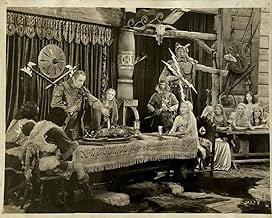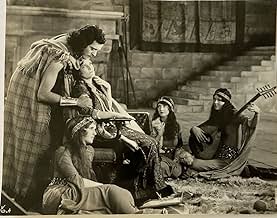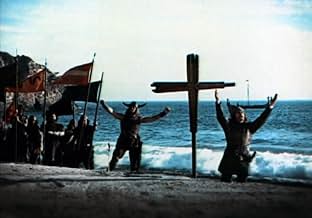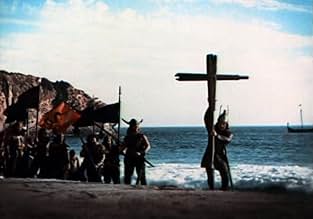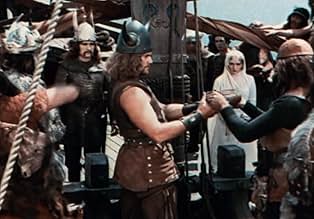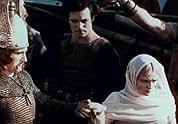VALUTAZIONE IMDb
6,6/10
512
LA TUA VALUTAZIONE
Aggiungi una trama nella tua linguaVikings compete for power and the love of a woman.Vikings compete for power and the love of a woman.Vikings compete for power and the love of a woman.
- Regia
- Sceneggiatura
- Star
Anders Randolf
- Eric the Red
- (as Anders Randolph)
Harry Woods
- Egil
- (as Harry Lewis Woods)
Claire McDowell
- Lady Editha
- (as Claire MacDowell)
Iron Eyes Cody
- Indian
- (non citato nei titoli originali)
Frank Ellis
- Man Who Gives Sword to Alwin
- (non citato nei titoli originali)
Eugene McDonald
- Minor Role
- (non citato nei titoli originali)
Francis McDonald
- Viking Friend of Leif
- (non citato nei titoli originali)
Lon Poff
- Friar Slain by Vikings
- (non citato nei titoli originali)
Angelo Rossitto
- Viking Dwarf
- (non citato nei titoli originali)
Dick Sutherland
- Viking
- (non citato nei titoli originali)
Recensioni in evidenza
Viking, The (1928)
** 1/2 (out of 4)
Leif Ericsson (Donald Crisp) sales off in hopes of going West of Greenland looking for uncharted land. Along the way he battles with viking queen Helga (Pauline Starke) as well as a slave (LeRoy Mason) she bought. If you're looking for a history lesson then I'd recommend you get a book because there are certainly many liberties taken with the "truth" here. However, at the same time, I've always said that you shouldn't come into a movie expecting a history lesson because a movies main goal should be to entertain you and for the most part THE VIKING is an entertaining film. It is somewhat historic because it was an all-color production that has some of the best looking 2-strip Technicolor that you're going to see. Coming at the end of the silent era we're also greeted with a soundtrack as well as several sound effects. I don't think there's any question that the main reason to see this is for the Technicolor, which is certainly very beautiful and there's also no question that MGM went all out to make sure there were plenty of colorful items in front of the camera. The look of the costumes, sets and ships are certainly beautiful to see in color and you can tell that the studio pumped up the look so they could show off all the colors. The beautiful blues of the seas were a major highlight as was the bloody red that actually happens during some of the more violent scenes including one man get stabbed as well as another getting an ax in the head. The sound effects are mainly crowd noises such as cheers but there are still enough of them to make you forget you're watching a silent movie. The actual story being told is rather weak because there's a love triangle that really goes no where and some of the alterations to history are a tad bit funny and I don't think the filmmakers were wanting you to be laughing. The three leads are decent in their roles but I'd be lying if I said any of them really stood out. There are some rather wild moments including a brief bit where the men believes there's a witch and ghost below decks and another violent fight where the Pagans go after the Christians. Fans of Technicolor will certainly want to check this out as will silent film buffs but I'd be willing to bet that the rest will find themselves bored. THE VIKING isn't perfect and it's too flawed to be a good movie but there's some entertainment to be had.
** 1/2 (out of 4)
Leif Ericsson (Donald Crisp) sales off in hopes of going West of Greenland looking for uncharted land. Along the way he battles with viking queen Helga (Pauline Starke) as well as a slave (LeRoy Mason) she bought. If you're looking for a history lesson then I'd recommend you get a book because there are certainly many liberties taken with the "truth" here. However, at the same time, I've always said that you shouldn't come into a movie expecting a history lesson because a movies main goal should be to entertain you and for the most part THE VIKING is an entertaining film. It is somewhat historic because it was an all-color production that has some of the best looking 2-strip Technicolor that you're going to see. Coming at the end of the silent era we're also greeted with a soundtrack as well as several sound effects. I don't think there's any question that the main reason to see this is for the Technicolor, which is certainly very beautiful and there's also no question that MGM went all out to make sure there were plenty of colorful items in front of the camera. The look of the costumes, sets and ships are certainly beautiful to see in color and you can tell that the studio pumped up the look so they could show off all the colors. The beautiful blues of the seas were a major highlight as was the bloody red that actually happens during some of the more violent scenes including one man get stabbed as well as another getting an ax in the head. The sound effects are mainly crowd noises such as cheers but there are still enough of them to make you forget you're watching a silent movie. The actual story being told is rather weak because there's a love triangle that really goes no where and some of the alterations to history are a tad bit funny and I don't think the filmmakers were wanting you to be laughing. The three leads are decent in their roles but I'd be lying if I said any of them really stood out. There are some rather wild moments including a brief bit where the men believes there's a witch and ghost below decks and another violent fight where the Pagans go after the Christians. Fans of Technicolor will certainly want to check this out as will silent film buffs but I'd be willing to bet that the rest will find themselves bored. THE VIKING isn't perfect and it's too flawed to be a good movie but there's some entertainment to be had.
THE VIKING of 1928 still appears to be, in a way, a strikingly absorbing picture. Although it seems that any commitment to viewing this movie may be a privilege of some little group of film scholars, claiming that it leaves no impression whatsoever would surely belittle the significance of silent cinema along with its unique appeal. Obviously, it could not stand a chance against many modern 'pseudo-epic adventures' that heap us with cheap effects which, at moments, cross dangerous borderline placing us at risk of being deprived of imagination. With that in mind, its two strip Technicolor effects would merely appear laughable for some but, paradoxically, renewing for others. Yes, some of its awe-inspiring charm that initially contributed to its adventure merit, still remains.
A misleading assumption lies in a viewpoint that solely two strip Technicolor (for which the movie is most famous) makes THE VIKING worth seeing. Of course, it is impossible to miss this point when even mentioning this movie. Nevertheless, what strikes me most about this film is its storytelling and the fact that it evokes the courage of the Vikings no less than their cruelty. Meanwhile, it does not fall into temptation of reducing them to sheer savages from a purely subjective standpoint of 'baddies.' So to say, such an early achievement becomes authentic and, at the same time, gains realistic targets. It is not only executed in the character of Leif Eriksson (Donald Crisp) who travels towards the new shores but, even, in Erik the Red (Anders Randolf), his father. The sophisticated nature of his character is prompted by contrast within him. On the one hand, his axe is used against his political and religious enemies, even his own son when he discovers his new faith. One the other hand, he draws a very humane conclusion in a memorable scene: 'Leif is my son after all.
THE VIKING with no great stars of the time (being an MGM production), contains all the pictorial elements that we find in cinema of any decade. It substantially depicts love, revenge, fight. We have a Northumbria context of Alwin (LeRoy Mason), taken as a slave, we have a beautiful prototype of female warrior, Helga played by Pauline Starke (of course, a blonde beauty as it is a movie about the Vikings after all), we have kings of two opposing policies, we have this eternal conflict between Christian faith (represented by King Olaf of Norway and his followers, including Erik Leifsson) and pagan cults (represented by Erik the Red, Leif's father, the king of Greenland). Predictably, the Christians are depicted as loving, understanding and forgiving while the pagans are cruel. Yet, there is some nobility in both groups (again with reference to a more psychological approach). Their confrontation, however, is one of the most authentic moments of the theme ever found in silent cinema. Finally, we have the theme of new land, promised land, America (yes, long before Columbus) so much appealing to the audiences of the late 1920s.
But the film is no serious stuff and it should never be treated like one. It is, first and foremost, adventure and entertainment. Just to recall some scenes that have truly stood a test of time and are no less entertaining than they must have been in the late 1920s, including the depiction of Greenland, Vikings' feasts (less savage than in 1958 Fleischer's film), love plot between Alwin and Helga, Egil/Alwin vibrant fight. On the subject of Helga, the beautiful warrior blonde, much credit to Pauline Starke's inspiring performance. The idea of such a female character was not new in this period of silent films. We should remember the lost film QUEEN OF SHEBA and the famous chariot race of the queen and princess Vashti. Nevertheless, Starke's portrayal must have occurred revelatory as early as in 1928 combining appeal and authenticity.
I agree with the opinion of those viewers who praise this film and recommend others to seek it out. Perhaps, it is flawed historically; surely, it is no towering entertainment for viewers used to most dazzling spectacles of our decade. Nonetheless, I believe that anyone may find something for themselves in this early Technicolor treasure and find its reasonable running time fruitful and memorable.
A misleading assumption lies in a viewpoint that solely two strip Technicolor (for which the movie is most famous) makes THE VIKING worth seeing. Of course, it is impossible to miss this point when even mentioning this movie. Nevertheless, what strikes me most about this film is its storytelling and the fact that it evokes the courage of the Vikings no less than their cruelty. Meanwhile, it does not fall into temptation of reducing them to sheer savages from a purely subjective standpoint of 'baddies.' So to say, such an early achievement becomes authentic and, at the same time, gains realistic targets. It is not only executed in the character of Leif Eriksson (Donald Crisp) who travels towards the new shores but, even, in Erik the Red (Anders Randolf), his father. The sophisticated nature of his character is prompted by contrast within him. On the one hand, his axe is used against his political and religious enemies, even his own son when he discovers his new faith. One the other hand, he draws a very humane conclusion in a memorable scene: 'Leif is my son after all.
THE VIKING with no great stars of the time (being an MGM production), contains all the pictorial elements that we find in cinema of any decade. It substantially depicts love, revenge, fight. We have a Northumbria context of Alwin (LeRoy Mason), taken as a slave, we have a beautiful prototype of female warrior, Helga played by Pauline Starke (of course, a blonde beauty as it is a movie about the Vikings after all), we have kings of two opposing policies, we have this eternal conflict between Christian faith (represented by King Olaf of Norway and his followers, including Erik Leifsson) and pagan cults (represented by Erik the Red, Leif's father, the king of Greenland). Predictably, the Christians are depicted as loving, understanding and forgiving while the pagans are cruel. Yet, there is some nobility in both groups (again with reference to a more psychological approach). Their confrontation, however, is one of the most authentic moments of the theme ever found in silent cinema. Finally, we have the theme of new land, promised land, America (yes, long before Columbus) so much appealing to the audiences of the late 1920s.
But the film is no serious stuff and it should never be treated like one. It is, first and foremost, adventure and entertainment. Just to recall some scenes that have truly stood a test of time and are no less entertaining than they must have been in the late 1920s, including the depiction of Greenland, Vikings' feasts (less savage than in 1958 Fleischer's film), love plot between Alwin and Helga, Egil/Alwin vibrant fight. On the subject of Helga, the beautiful warrior blonde, much credit to Pauline Starke's inspiring performance. The idea of such a female character was not new in this period of silent films. We should remember the lost film QUEEN OF SHEBA and the famous chariot race of the queen and princess Vashti. Nevertheless, Starke's portrayal must have occurred revelatory as early as in 1928 combining appeal and authenticity.
I agree with the opinion of those viewers who praise this film and recommend others to seek it out. Perhaps, it is flawed historically; surely, it is no towering entertainment for viewers used to most dazzling spectacles of our decade. Nonetheless, I believe that anyone may find something for themselves in this early Technicolor treasure and find its reasonable running time fruitful and memorable.
THE VIKING is a film I happened to come upon on TCM the other night, immediately recognizing DONALD CRISP as Leif Ericsson. I was very impressed with the female lead, PAULINE STARKE as Helga, whose lovely face, high cheekbones and steady gaze withstood all those color closeups in fine style. She also happened to be well cast at the headstrong heroine who takes a wealthy nobleman for her slave.
But what really amazed me is the quality of the Technicolor photography, at least ten years before Hollywood was making use of color photography in some of its major films.
The TCM print featured some incidental sound effects and background music. At times, I forgot I was watching a silent film and the use of title cards was minimal.
Well worth watching as a curiosity, but not for historical accuracy.
But what really amazed me is the quality of the Technicolor photography, at least ten years before Hollywood was making use of color photography in some of its major films.
The TCM print featured some incidental sound effects and background music. At times, I forgot I was watching a silent film and the use of title cards was minimal.
Well worth watching as a curiosity, but not for historical accuracy.
Hollywood's major studios had used Technicolor Corporation's color technology for a number of years in the 1920s, but had limited its expensive use for just short segments within their feature films. Besides Douglas Fairbanks's 1926 "The Black Pirate," no studio went full bore in adopting the technology for its motion pictures. Technicolor had produced three films on its own to demonstrate its processes, including 1922's "The Toll of the Sea." By 1928, the company was prepared to unveil its latest color system, labeled 'Process 3' film. Among its highlights was the realistic flesh tones of its actors as well as an increase in vibrancy in colors from the previous processes. Added to its wow factor was be an embedded audio track able to play a springy musical soundtrack along with special sound effects. Its end result was the November 1928 release of "The Viking."
Viewers could readily see Technicolor's years of diligent work to get the skin tones just right: actress Pauline Starke as Helga, demonstrates the perfection of the hues with her low-cut costume exposing a ton of flesh. The abundant shots of clear blue skies and the equally aqua ocean capturing a Viking ship's journey to North America were designed to show its richer blues. The narrative was secondary to the visuals. Since the company had to have a plot within the movie, it adapted the script from Ottilie Liljencrantz's 1902 novel 'The Thrall of Leif the Lucky.' Critics complained about the lack of battle scenes, but "The Viking's" purpose was to sell the new vibrant colors to Hollywood and international film studios.
"The Viking's" plot involves Earl of Northumbria (LeRoy Mason) captured in a Viking raid. He's bought by Helga, whose guardian is Leif Ericsson, to be her slave. She falls in love with him despite the coupling being against the Norse code. Several sub-plots unfold, including the influence of Christianity on Leif Ericsson (Donald Crisp) while he and his colleagues butt heads against those who stand with the traditional paganism, a friction that plays into the Vikings' approach to North America.
Irving Thalberg, head of MGM's production, was so enthralled with the look of "The Viking" he convinced his studio to distribute the movie. The film didn't exactly light up the box office, but it did establish a working relationship between Technicolor and MGM, revolutionizing cinema in the coming years.
"The Viking's" conclusion claims the Ericsson colonization of North America took place in what is now Newport, Rhode Island, as evidence by a large tower the Danes erected there. The mysterious "Newport Tower" was later determined to be the remains of a 1650s windmill. But in 1837, a Danish archaeologist suggested it was constructed by the Vikings because he believed a Norse settlement existed from the evidence derived from the nearby Dighton Rock. In fact, Henry Longfellow wrote a poem, 'The Skeleton in Armor,' about the tower's Norse origins. The speculation has since been disproven.
Viewers could readily see Technicolor's years of diligent work to get the skin tones just right: actress Pauline Starke as Helga, demonstrates the perfection of the hues with her low-cut costume exposing a ton of flesh. The abundant shots of clear blue skies and the equally aqua ocean capturing a Viking ship's journey to North America were designed to show its richer blues. The narrative was secondary to the visuals. Since the company had to have a plot within the movie, it adapted the script from Ottilie Liljencrantz's 1902 novel 'The Thrall of Leif the Lucky.' Critics complained about the lack of battle scenes, but "The Viking's" purpose was to sell the new vibrant colors to Hollywood and international film studios.
"The Viking's" plot involves Earl of Northumbria (LeRoy Mason) captured in a Viking raid. He's bought by Helga, whose guardian is Leif Ericsson, to be her slave. She falls in love with him despite the coupling being against the Norse code. Several sub-plots unfold, including the influence of Christianity on Leif Ericsson (Donald Crisp) while he and his colleagues butt heads against those who stand with the traditional paganism, a friction that plays into the Vikings' approach to North America.
Irving Thalberg, head of MGM's production, was so enthralled with the look of "The Viking" he convinced his studio to distribute the movie. The film didn't exactly light up the box office, but it did establish a working relationship between Technicolor and MGM, revolutionizing cinema in the coming years.
"The Viking's" conclusion claims the Ericsson colonization of North America took place in what is now Newport, Rhode Island, as evidence by a large tower the Danes erected there. The mysterious "Newport Tower" was later determined to be the remains of a 1650s windmill. But in 1837, a Danish archaeologist suggested it was constructed by the Vikings because he believed a Norse settlement existed from the evidence derived from the nearby Dighton Rock. In fact, Henry Longfellow wrote a poem, 'The Skeleton in Armor,' about the tower's Norse origins. The speculation has since been disproven.
A handsomely staged silent epic created to showcase the new 2-strip Technicolor process. All the male leads fall for Viking maiden Helga (Pauline Starke, looking exceedingly fetching in her Viking outfits), but there's little doubt about which of them will claim her heart. Worth catching for the sight of a young Donald Crisp looking like a drummer in some early 1970s prog rock band.
Lo sapevi?
- QuizWhen the film opened at the Embassy Theatre in New York City on November 28, 1928, it was still silent and was accompanied by a live orchestral accompaniment. In December 1928 a musical score was recorded, sound-on-disc, and this version was distributed by Metro-Goldwyn-Mayer (MGM) in 1929.
- BlooperViking women neither shaved their underarms nor wore the strapless bustiers.
- Citazioni
Title Card: A thousand years ago, long before any white man set foot on the American shore, Viking sea rovers sailed out of the north and down the waterways of the world. These were men of might, who laughed in the teeth of the tempest, and leaped into battle with a song. Plundering - ravaging - they raided the coast of Europe - until the whole world trembled at the very name - THE VIKING.
- Curiosità sui creditiThe title card bills the three stars in the order Pauline Starke [top billing], Donald Crisp [second billing], and Le Roy Mason [third billing]. But the opening credits end with "The Players" listed in the order: first "Leif Erickson ... Donald Crisp," second "Helga . . . Pauline Starke, third "Alwin . . . Le Roy Mason," etc. The characters appear on screen in the order Alwin, Helga, and Leif Erickson.
- ConnessioniFeatured in New England Legends: Creepy Christmas (2019)
I più visti
Accedi per valutare e creare un elenco di titoli salvati per ottenere consigli personalizzati
- How long is The Viking?Powered by Alexa
Dettagli
Botteghino
- Budget
- 325.000 USD (previsto)
- Tempo di esecuzione1 ora 30 minuti
Contribuisci a questa pagina
Suggerisci una modifica o aggiungi i contenuti mancanti

Divario superiore
By what name was I vichinghi (1928) officially released in Canada in English?
Rispondi

